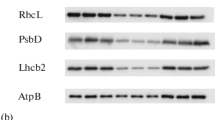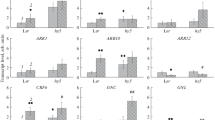Abstract
The PsbS gene product (PSII-S) which is an integral subunit of photosystem II has recently been reported to be a new type of pigment-binding protein [11]. The chlorophylls of the PSII-S protein exhibit weak excitonic coupling and this protein is stable also in the absence of pigments. Here we investigated the expression of the PsbS gene in etiolated spinach seedlings grown either in complete darkness or exposed to light of various qualities. The results obtained reveal that the PsbS gene expression in etiolated spinach plants is subjected to endogenous control. This developmental control occurs at different levels of gene expression and results in transient accumulation of the PsbS transcripts with progressing etiolation. During the first two days after emerging of the cotyledons from the seed coat the steady-state level of the PsbS transcripts is regulated mainly through increased transcriptional activity of the PsbS gene. Prolonged growth of the seedlings in the dark resulted in additional post-transcriptional control of the PsbS transcript level. Translational activity of PsbS mRNA estimated by an integration of mRNA into polysomal complexes shows that the translation rate of PsbS mRNA is less influenced by seedling age. The maximal rate of translation is reached at the first day after cotyledons emergence but the translational activity of PsbS mRNA remains still high (50% of maximum) in 8-day old etiolated spinach plants. In addition to the light-independent developmental control, the PsbS gene expression is positively regulated by phytochrome in etiolated seedlings exposed to light. Red light, however, negatively influences the abundance of PsbS transcripts at post-transcriptional level. Studies on blue or far-red light effects reveal that the accumulation of PsbS transcripts exhibits the characteristics of very-low-fluence responses of the phytochrome receptor.
Similar content being viewed by others
Abbreviations
- Cab,:
-
genes coding for chlorophyll a/b-binding proteins
- ELIPs:
-
early light-inducible proteins
- Elip,:
-
gene coding for early light-inducible protein
- Pcr,:
-
gene coding for protochlorophyllide reductase
- PhyA,:
-
gene coding for phytochrome type I protein
- PS II:
-
photosystem II
- PSII-S:
-
22 kDa protein of PSII
- PsbS,:
-
gene coding for 22 kDa protein of PSII
- rbcL,:
-
gene coding for large subunit of ribulose-bisphosphate carboxylase
- RbcS,:
-
gene coding for small subunit of ribulose-bisphosphate carboxylase
- TubB,:
-
gene coding for β-tubulin
References
Adamska I: Regulation of early light-inducible protein gene expression by blue and red light in etiolated seedlings involves nuclear and plastid factors. Plant Physiol 107: 1167–1175 (1995).
Adamska I, Kloppstech K, Ohad I: Early light-inducible protein in pea is stable during light stress but is degraded during recovery at low light intensity. J Biol Chem 268: 5438–5444 (1993).
Adamska I, Ohad I, Kloppstech K: Synthesis of the early light-inducible protein is controlled by blue light and related to light stress. Proc Natl Acad Sci USA 89: 2610–2613 (1992).
Brusslan JA, Tobin EM: Light-independent developmental regulation of cab gene expression in Arabidopsis thaliana seedlings. Proc Natl Acad Sci USA 89: 7791–7795 (1992).
Deng XW, Stern DB, Tonkyn JC, Gruissem W: Plastid run on transcription. Application to determine the transcriptional regulation of spinach plastid genes. J Biol Chem 262: 9641–9648 (1987).
Dieuaide M, Brouquisse R, Pradet A, Raymond P: Increased fatty acid β-oxidation after glucose starvation in maize root tips. Plant Physiol 99: 595–600 (1992).
El Amrani A, Couee I, Carde JP, Gaudillere JP, Raymond P: Modifications of etioplasts in cotyledones during prolonged dark growth of sugar beet seedlings: identification of etiolation-related plastidal aminopeptidase activities. Plant Physiol 106: 1555–1565 (1994).
Fluhr R, Chua NH: Developmental regulation of two genes encoding ribulose-bisphosphate carboxylase small subunit in pea and transgenic petunia plants. Phytochrome responses and blue light induction. Proc Natl Acad Sci USA 83: 2358–2362 (1986).
Funk C, Adamska I, Green BR, Andersson B, Renger R: The nuclear-encoded chlorophyll-binding PSII-S protein is stable in the absence of pigments. J Biol Chem 270: 30141–30147 (1995).
Funk C, Schröder WP, Green BR, Renger G, Andersson B: The intrinsic 22 kDa protein is a chlorophyll-binding subunit of photosystem II. FEBS Lett 342: 261–266 (1994).
Funk C, Schröder WP, Napiwotzki A, Tjus SE, Renger G, Andersson B: The PSII-S protein of higher plants: a new type of pigment-binding protein. Biochemistry 34: 11133–11141 (1995).
Gallagher TF, Ellis JR: Light stimulated transcription of genes for two chloroplast polypeptides in isolated pea leaf nuclei. EMBO J 1: 1493–1498 (1982).
Gallie DR: Posttranscriptional regulation of gene expression in plants. Annu rev Plant Physiol Plant Mol Biol 44: 77–105 (1993).
Ghanotakis DG, Waggoner CM, Bowlby NR, Demetriou DM, Babcock GT, Yocum CF: Comparative structural and catalytic properties of oxygen-evolving photosystem II preparations. Photosynth Res 14: 191–199 (1987).
Green BR, Pichersky E: Hypothesis for the evolution of three-helix chl a/b and chl a/c light-harvesting antenna proteins from two-helix and four-helix ancestors. Photosynth Res 39: 149–162 (1994).
Hundal T, Virgin I, Styring S, Anderson B: Changes in the organization of photosystem II following light-induced D1 protein degradation. Biochim Biophys Acta 1017: 235–241 (1990).
Jenkins GI: Photoregulation of gene epression in plants. Photochem Photobiol 48: 821–832 (1988).
Karlin-Neuman GA, Sun L, Tobin EM: Expression of light-harvesting chlorophyll a/b-protein genes is phytochrome-regulated in etiolated Arabidopsis thaliana seedlings. Plant Physiol 88: 1323–1331 (1988).
Kaufman LS, Thompson WF, Briggs WR: Different red light requirements for phytochrome induced accumulation of cab RNA and rbcS RNA. Science 226: 1447–1449 (1984).
Kim S, Sandusky P, Bowlby NR, Aebersold R, Green BR, Vlahakis S, Yocum CF, Pichersky E: Characterization of a spinach PsbS cDNA encoding the 22 kDa protein of photosystem II. FEBS Lett 314: 67–71 (1992).
Ljungberg U, Ékerlund HE, Andersson B: Isolation and characterization of the 10 kDa and 22 kDa polypeptides of higher plant photosystem II. Eur J Biochem 158: 477–482 (1986).
Marrs KA, Kaufman LS: Blue light regulation of transcription for nuclear genes in pea. Proc Natl Acad Sci USA 86: 4492–4495 (1989).
Mohr H: Criteria for photoreceptor involvement. In: Smith H, Holmes M (eds) Techniques in Photomorphogenesis, pp. 13–42. Academic Press, London (1984).
Mösinger E, Batschauer A, Apel K, Schäfer E, Briggs WR: Phytochrome regulation of greening in barley: effects on mRNA abundance and transcriptional activity of isolated nuclei. Plant Physiol 86: 706–710 (1988).
Mösinger E, Batschauer A, Schäfer E, Apel K: Phytochrome control of in vitro transcription of specific genes in isolated nuclei from barley (Hordeum vulgare). Eur J Biochem 147: 137–142 (1985).
Mullet JE: Chloroplast development and gene expression. Annu Rev Plant Physiol Plant Mol Biol 39: 475–502 (1988).
Nagy F, Kay SA, Boutry M, Hsu MY, Chua NH: Phytochrome-controlled expression of a wheat Cab gene in transgenic tobacco seedlings. EMBO J 5: 1119–1124 (1986).
Pötter E, Kloppstech K: Effect of light stress on the expression of early light-inducible proteins in barley. Eur J Biochem 214: 779–786 (1993).
Rapp JC, Mullet JE: Chloroplast transcription is required to express the nuclear gene rbcS and cab. Plastid DNA copy number is regulated independently. Plant Mol Biol 17: 813–823 (1991).
Sullivan TD, Christensen AH, Quail PH: Isolation and characterization of a maize chlorophyll a/b binding protein gene that produces high level of mRNA in the dark. Mol Gen Genet 215: 431–440 (1989).
Taylor WC: Regulatory interactions between nuclear and plastid genomes. Annu Rev Plant Physiol Plant Mol Biol 40: 211–233 (1989).
Thompson WF, White MJ: Physiological and molecular studies of light-regulated nuclear genes in higher plants. Annu Rev Plant Physiol Plant Mol Biol 42: 423–466 (1991).
Wallbraun M, Kim S, Green BR, Piechulla B, Pichersky E: Nucleotide sequence of a tomato PsbS gene. Plant Physiol 106: 1703–1704 (1994).
Wedel N, Klein R, Ljungberg U, Andersson B, Hermann RG: The single copy gene PsbS codes for a phylogenetically intriguing 22 kDa polypeptide of photosystem II. FEBS Lett 314: 61–66 (1992).
Author information
Authors and Affiliations
Rights and permissions
About this article
Cite this article
Adamska, I., Funk, C., Renger, G. et al. Developmental regulation of the PsbS gene expression in spinach seedlings: the role of phytochrome. Plant Mol Biol 31, 793–802 (1996). https://doi.org/10.1007/BF00019467
Received:
Accepted:
Issue Date:
DOI: https://doi.org/10.1007/BF00019467




